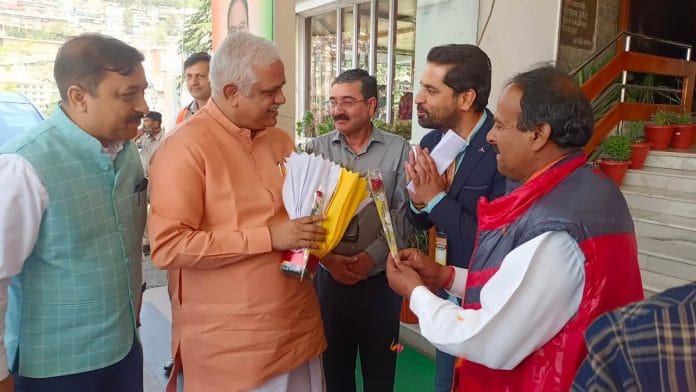New Delhi: A pitched battle over the use of the words ‘savarna’ (upper-caste) and ‘samanya varg’ (general category) has put Himachal Pradesh’s BJP government in a tricky position, especially with assembly polls scheduled later this year.
While sections of the upper caste population, as well as their representatives in the party, are agitating for the term ‘Savarna Aayog’ to be used for a panel being created to address their grievances, the party is sticking to its guns about using the label ‘Samanya Varg Aayog’ (commission for the general category), instead so as to not alienate Dalit and OBC voters.
BJP sources said that in a closed-door meeting earlier this week in Shimla, leaders of the party’s Scheduled Caste (SC) Morcha told national general secretary (organisation) B.L. Santhosh that if the word savarna is used, it will hit the Dalit vote-bank in the state. According to the 2011 Census, Dalits comprise about 25 per cent of the population of Himachal Pradesh.
Santhosh has taken this feedback to heart. Asserting that the BJP and RSS work for the welfare of all, he told party members in Himachal to eschew the use of the term ‘savarna‘ in general, and to stick to ‘samanya‘, so as to not propagate caste-based discrimination and send out the “wrong” message to the Dalit and OBC communities.
A BJP functionary told ThePrint that the conversation started when Santhosh asked state SC Morcha chief Nitin Kumar whether he was regularly interacting with his RSS counterpart about issues in the community. To this, Kumar reportedly replied that he had communicated that the term ‘savarna’ was hurtful to the SC community and that its use gave undue prominence to the upper castes. Santhosh had then made his observation that the term should never be used in public meetings and conversations, the BJP functionary said.
Also Read: BJP turns to ‘Mission Shimla’ before Himachal polls, with pay hikes & thank you notes from CM
Long tussle over terminology
Last year, soon after the OBC Bill was passed, some states saw agitations demanding the formation of a ‘Savarna Aayog’ for the welfare of the upper castes.
In Himachal, too, there were huge protests around the issue in December 2021, leading to Chief Minister Jai Ram Thakur announcing in the winter session of the assembly that a panel for upper castes would be set up.
In February, the state government issued a notification for the constitution of a panel to address the grievances and needs of this section. However, the news generated even more protests, partly due to the government’s decision to call this commission the ‘Samanya Varg Aayog’, and partly because of the nature of the notification.
On 10 March, protesters belonging to upper caste groups in Shimla pelted stones at the local administration, demanding that the commission should be established through an act rather than a notification, and that it should be referred to by the term “savarna” rather than the more vague “samanya varg” or general category. Upper caste groups have also demanded that the commission should prevent misuse of the SC/ST Act.
Notably, the BJP-ruled state of Madhya Pradesh also constituted a panel for the upper castes last year after protests, but proposed the name ‘Savarna Aayog’.
Caste arithmetic in Himachal
The upper castes have the numeric advantage in Himachal, with Rajputs (about 32 per cent) and Brahmins (18 per cent) together comprising approximately 50 per cent of the population. SCs account for 25 per cent of the population, STs 6 per cent, and OBCs 13 per cent.
However, even though the upper castes are the BJP’s traditional voters, it is laying greater emphasis on the Dalit vote-bank this upcoming assembly election.
A major reason for this is the party’s performance in the 2017 assembly elections. The 68-seat Himachal assembly has 17 reserved seats for SCs, out of which the BJP had won 13.
This vote-base, however, is currently uneasy about the upper caste agitation and the formation of the panel, which is something the BJP has been apparently trying to ameliorate. For instance, the party nominated Dalit scholar Dr Sikander Kumar for the only Rajya Sabha seat from the state, and he was elected unopposed last month.
Significantly, the state party chief Suresh Kashyap is also a prominent Dalit leader, as is the health & family welfare minister Rajiv Saizal.
Prep for polls
With the incumbent BJP government in Himachal facing polls this year, the party’s central leadership is directing plenty of attention towards the hill state.
In this week’s visit to the state, B.L. Santhosh conducted meetings with top Himachal leaders to review their preparedness for the elections.
In his interactions with the state leaders, Santhosh emphasised the need to connect at a personal level with voters and beneficiaries of government schemes by visiting their homes and listening to their feedback.
“His message was clear: Setting up booth meeting and conferences are normal organisational work but they won’t give the real picture since party workers will generally only say good things. You get the real picture, including of shortcomings, only if you visit the homes of key voters and beneficiaries and let them open up about their problems,” BJP Himachal OBC Morcha head Om Prakash Chaudhary told ThePrint.
According to Chaudhary, Santhosh set a target for every wing of the BJP to visit one lakh beneficiary homes in a month.
Last week, BJP president J.P. Nadda visited Himachal, his home state, for a meeting with the party leadership. This Friday, he also held a roadshow in the Kangra district.
(Edited by Asavari Singh)
Also Read: BJP plans to drop 20% MLAs for upcoming Himachal polls, decision based on ‘performance review’






